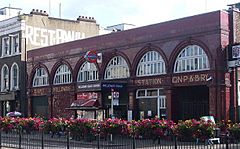Holloway Road tube station facts for kids
 |
|
| Location | Holloway |
|---|---|
| Local authority | Islington |
| Managed by | London Underground |
| Number of platforms | 2 |
| Fare zone | 2 |
| London Underground annual entry and exit | |
| 2007 | |
| 2008 | |
| 2009 | |
| Key dates | |
| 1906 | Opened |
| Other information | |
| Lists of stations | |
Holloway Road is a busy London Underground station. It is located in Holloway, a part of Islington in North London. The station is on the Piccadilly Line, one of London's main underground railway lines.
You can find Holloway Road station between Caledonian Road and Arsenal stations. It is part of Travelcard Zone 2, which helps people figure out how much their train ticket will cost. The station first opened its doors to passengers on 15 December 1906.
Contents
What is the Piccadilly Line?
The Piccadilly Line is a deep-level underground railway line. It runs from the north to the west of London. It connects many important places, including Heathrow Airport. The line is known for its dark blue colour on the Tube map.
Station History and Design
Holloway Road station was built by the Great Northern, Piccadilly and Brompton Railway. This company is now part of the London Underground. The station's design was created by the famous architect Leslie Green. He designed many Tube stations with a special look.
Leslie Green's stations often have a distinctive ox-blood red glazed terracotta exterior. Inside, they feature beautiful tiled passages and platforms. These tiles often show unique patterns or the station's name.
The Experimental Spiral Escalator
When Holloway Road station was being built, engineers tried something very new. They installed an experimental spiral escalator inside the station. This was a very unusual design, different from the straight escalators we see today.
- Spiral escalator during construction, 1906
- Parts of the experimental spiral escalator
The spiral escalator was meant to save space. However, it was never actually used by the public. It was found to be too difficult to operate safely. Instead, lifts were installed to take passengers between the street and the platforms. Even though it wasn't used, it shows how engineers were always trying new ideas.
Ticket Hall and Platforms
The station has two platforms, one for trains going towards central London and one for trains going north. The ticket hall, where you buy your tickets, has changed over the years.
- Ticket hall, 1927
- Holloway Road station, 2001
The platforms still show some of the original tiling designed by Leslie Green. These tiles are a cool part of London's history.
Travelcard Zones
London's public transport system uses "Travelcard Zones" to help set ticket prices. Zone 1 is the very centre of London. As you go further out, the zone numbers get higher. Holloway Road station is in Zone 2, meaning it's just outside the busiest central area.
Images for kids
-
Westbound platform looking north towards Cockfosters







